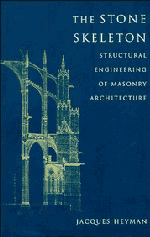1 - Introduction
Published online by Cambridge University Press: 05 August 2014
Summary
It is, perhaps, trivial to remark of Greek, Roman, Byzantine, Romanesque and Gothic buildings that some of them still exist. The observation has force, however, when placed in a structural context. A masonry structure — a cathedral from the High Gothic period, for example — may be viewed in many ways: from the liturgical aspect, or the cultural, the historical, or the aesthetic, all of which may give rise to disputes of one sort or another. There remains one viewpoint which seems to engender an unequivocal statement: the large masonry building is clearly a feat of structural engineering. Moreover, the mere survival of ancient buildings implies an extreme stability of their structure.
Minor failures have, of course, occurred, and there have been major catastrophes. The fact remains that two severe earthquakes only slightly damaged Hagia Sofia, and the bombardments of the Second World War often resulted in a medieval cathedral left standing in the ruins of a modern city. At a much less severe level of disturbance, the continual shifts and settlements of foundations experienced over the centuries seem to cause the masonry structure no real distress, although, as will be seen, there may be an initial high-risk period of about a generation after completion of the building. It is the intention of this book to explain this extraordinary stability. A discussion of the actual structural behaviour of masonry is necessarily involved, and some of the history of structural analysis will be touched on, since it may help to deepen understanding.
- Type
- Chapter
- Information
- The Stone SkeletonStructural Engineering of Masonry Architecture, pp. 1 - 11Publisher: Cambridge University PressPrint publication year: 1995



